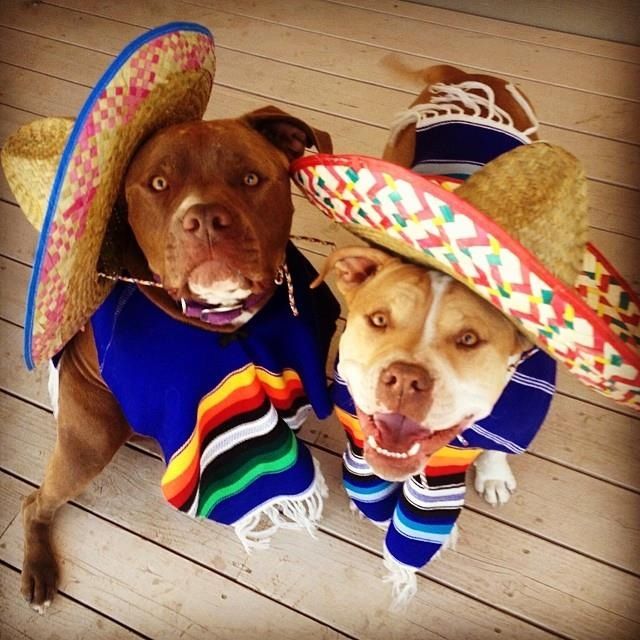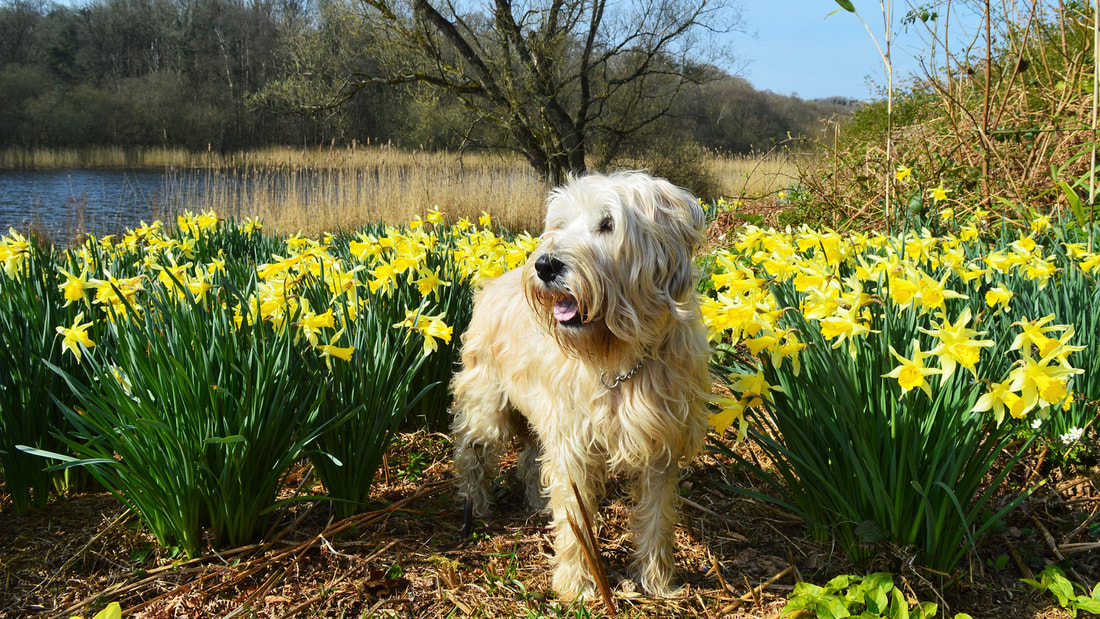|
It's May, a month full of flowers after April's showers!
This month we will be talking about plants and your pets, learn about two of Mexico's most famous breeds, the best way to celebrate Cinco de Mayo with your critters, Mothers Day, and honor the fallen among our brave Military animals. Meet Roman and see his Story in Pictures, Check out the growing section of the website dedicated to information on Training, Pet Health, Safety, and more under our FAQ. Don't forget, if we don't have the type of pet that you want to shower with affection and causes your heart bloom with joy, there are thousands of pets in rescues and shelters just waiting for someone and that someone could be you! All our best to you and yours. Happy May! - ALPRAS Team Members |
|
Cinco de Mayo in Latin America, Spanish for "Fifth of May") is an annual celebration held on May 5. The date is observed to commemorate the Mexican Army's victory over the French Empire at the Battle of Puebla, on May 5, 1862, under the leadership of General Ignacio Zaragoza. In the United States, Cinco de Mayo has taken on a significance beyond that in Mexico. More popularly celebrated in the United States than Mexico, the date has become associated with the celebration of Mexican-American culture. In Mexico, the commemoration of the battle continues to be mostly ceremonial, such as through military parades or battle reenactments. |
|
The modern American focus on that day first started in California in 1863 in response to the resistance to French rule in Mexico. Far up in the gold country town of Columbia (now Columbia State Park), Mexican miners were so overjoyed at the news that they spontaneously fired off rifle shots and fireworks, sang patriotic songs and made impromptu speeches. |
|
To celebrate, many display Cinco de Mayo banners while school districts hold special events to educate students about its historical significance. Special events and celebrations highlight Mexican culture, especially in its music and regional dancing.Examples include: baile folklórico and mariachi demonstrations held annually at the Plaza del Pueblo de Los Ángeles, near Olvera Street. |
|
In Puebla, historical reenactments, parades, and meals take place to commemorate the Battle of Puebla. Parade participants dress as French and Mexican soldiers to reenact the battle. Every year the city also hosts the Festival Internacional de Puebla, which gathers national and international artists, traditional musicians and dancers as well as the Festival Internacional del Mole, with an emphasis on the city's iconic mole poblano.
Events tied to Cinco de Mayo also occur outside Mexico and the United States. Canada, the Cayman Islands, Jamaica, Australia, London, New Zealand, South Africa,Nigeria, Paris and Japan. As in the United States, celebrations elsewhere also emphasize Mexican cuisine, culture and music. |
So whats a good way to Celebrate Cinco de Mayo for and/or with my pets?
|
Cats in Mexico could use some help. Just like in the United States, Mexico's cats suffer misinformation and less attention than dogs. A lack of education has many areas of Mexico overrun with feral cats, and just like in the states, they become considered a nuisance like vermin and can be destroyed.
“Education is changing this (in Mexico), particularly with younger people,” adds Lola Cortina of San Miguel de Allende, where she founded a sanctuary for cats, Sancuario Feline Rey Ashoka, a no-kill facility. She regularly appears on local radio informing cat owners about needed veterinary care, behavior issues and busting myths along the way. We can help change things for cats both here in the US and in Mexico. So save one one of your Cinco de Mayo drinks for the cats of Mexico and donate a few bucks to an organization dedicated to helping cats find homes and become loved and important family members. You can also donate to low cost Spay/Neuter programs, Cat Sanctuaries, or support a Feral Cat Colony. These worthy causes are definitely something to raise your glass to! Viva los Gatos!!! |
Chihuahua |
Xoloitzcuintli |
|
The Chihuahuai (pronounced Chee-wa-wa) is the smallest breed of dog and is named after the state of Chihuahua, Mexico. Chihuahuas come in a wide variety of colors, and two coat lengths. Although 'varieties' of Apple Head, Pear Head, and Deer Head Chihuahuas exist, most kennel clubs only recognize the standard Apple Head and diminutive size (4-6 lbs and 6-10 in) as a 'true' Chihuahua. The term 'Teacup' was only brought about by sellers to attract buyers and possibly the different head types as well. Regardless, Chihuahuas are considered the smallest breed of dog with a huge personality!
Chihuahuas are believed to be the descendants of the Techichi. A small South American dog that was bred by the Toltec civilization. During the Mesoamerican period (900-1168 CE.) The Techichi was bred for hunting, (yes, hunting!), companionship, food, and even for possessing of supernatural powers with the ability to see the future. Chihuahuas were also used as living hot-water bottles during illness or injury. Some believe this practice is where the idea of pain being transferred to animals from humans originated. This gave way to rituals such as burning the deceased with the dogs to exonerate the deceased human's sins and guide their owner in the underworld. There is some solid evidence of the Chihuahua being a direct descendant from the Techichi. Wheeled dog toys that were found at in Veracruz, Mexico date back to 100 AD and are believed to depict both apple head and deer head varieties of the Techichi. Effigy pots and sculptures were found in ancient burial shafts in Colima, Mexico dating back to 300 BC. These pots and sculptures depict a dog strikingly similar to the current day Chihuahua. Drawings found in the ruins of Chichen Itza on the Yucatan Peninsula that date back to the 5th century AD. DNA tests have shown that at least 70% of the present day Chihuahua is linked to the Techihchi with 30% being of an unknown origin. May have speculated what breeds may have joined in to create the modern day Chihuahua. This includes the Chinese Crested (who may have come with the Conquistadors) and the ancient Mexican breed Xoloitzcuintli. The Chihuahua is a fun little breed of dog who are often considered to have a 'Napoleon Complex'. They tend to be bossy with other dogs and have a 'clannish' mindset meaning they actually prefer the company of other Chihuahuas. With its small size the Chihuahua is a great apartment dog so city life is no problem. Due to their popularity they can have some genetic issues, so be sure to get one from a qualified breeder if you want one of these feisty little Chi's to be in your life. |
The Xoloitzcuintli (pronounced Show low eats qweent lee, or Xolo for short) is one of the most ancient breeds in the Western Hemisphere, it is estimated to have originated 3500 years ago in Mexico. Xolos served the Aztecs and Mayans as healers, hunters, guards and bed warmers. The Xolo were also occasionally used for food and a highly significant religious sacrificial token. Due to the delicacy of the meat the Xolo almost became extinct, if not for the Federation Canofila Mexicana (FCM) and a group of extraordinary Xolo saviours in the 1950's the breed possibly would not be here. Early expeditions to remote villages in Mexico gathered pure breeding copies which has become the foundation stock for the modern day Xoloitzcuintli breed.
As easily noticed, the Xolo is a generally hairless dog. The gene that produces the absence of hair is dominant, however some Xolos are born with a partial coat. Xolos often have tusk like canine teeth. Since this is considered a 'primitive breed', the Xolo doesn't suffer genetic health issues like most breeds. They exist from natural selection over thousands of years by nature rather than bred for a specific purpose by man. As aforementioned, the Xolo comes in two varieties: Hairless and Furred but they also come in three sizes:
Xolos are an intelligent, loyal and devoted companion that tends to be calm and cheerful. They can be good guard dogs as they are a very alert breed and initially reserved with strangers. The Xolo have a wide range of abilities. As a Show Dog they can also do both Agility and Obedience. Additionally they are competent Service and Therapy Dogs. The Xolo can make a wonderful pet, however puppies need to be well socialized from the early weeks (just like all dogs.) Xolos are credited with an intelligent and fast learning attitude which will require the owner to earn respect and a utilize a consistent and structured routine. As should be expected with people, during cold months the Xolo needs a Coat/Jacket and Sunscreen during the Warm ones. Just like people, they need regular baths, at least one a week and lotions safe for dogs. Unlike most dog breeds, there is no hiding it if they get overweight. A relatively active lifestyle and healthy foods (they really like fruits and veggies!) will keep a Xolo in tip top shape. Overall, the Xoloitzcuintli is a fantastic and fascinating breed of dog that has as rich a history as the country it comes from. |
***Note: All of this information has come from a variety of sources with academic backing consolidated in this article.***
Now that we know about some Mexican Dogs,
how do we celebrate Cinco de Mayo with them?
Dress Up! |
Candid Pictures! |
Festive Toys! |
...and of course, Donate to a Mexican Dog Rescue in your pups name!
Mom's are pretty incredible. We look on them with amazement realizing the care and sacrifice they make having and raising kids. This can double or triple. In some cases even more at one go! Every day roughly 10,000 humans are born in the United States. That's a whole lot of people! We know that most of these will grow up and eventually have kids of their own. But while we humans can knowingly manage our birth rates and the impact it has on the environment, animals don't have this knowledge.
While a good portion of us also have safety measures, and some healthcare, not all animals do either which is why we need to help female cats and dogs who are moms and aren't mothers yet. Spay and Vaccination can help keep overpopulation and disease at bay. While humans make a lot of people at 10,000 a day, cats and dogs make roughly 70,000 babies a day! Each female cat and dog can have at least 2 litters a year with an average of 2-6 babies (or more) each time. Even if only 2 survive and go on to make more, that number quickly adds up! Over 10 years 1 female cat and her offspring can theoretically produce just over 1 million cats. Just. One. Cat. Dogs don't fare much better despite often shorter lifespans and better management by people.
Now of course we don't live in a perfect world, feral animals have a higher mortality rate. Things happen and no matter how good a mom is, no matter what species and how much loving care is given. Even survivors aren't guaranteed safety. It is estimated that 70% of cats that make it into the shelter are euthanized. 1.5 million animals are euthanized in shelters every year in the United States. There is some good news though:
6.5 million animals enter shelters every year and while 1.5 are euthanized, 3.2 million are adopted every year and about 710,000 animals are returned to their owners! This is thanks to increased education and action on Spaying and Neutering animals and a larger effort to train and understand animals as well as adoption rates going up.
Much of this progress has been spearheaded by women. Mothers, Pet Moms, and Women Community Activists have invested immense effort and drive to take care of our furred and feathered kids. Whether it is Human Rights, Animal Rights, or protection for all living things and the planet we all reside on, Women and Moms everywhere have our back. On Mothers day, give more than flowers, give thanks to the Mothering person in your life and listen to what they have to say. Moms are Awesome!
While a good portion of us also have safety measures, and some healthcare, not all animals do either which is why we need to help female cats and dogs who are moms and aren't mothers yet. Spay and Vaccination can help keep overpopulation and disease at bay. While humans make a lot of people at 10,000 a day, cats and dogs make roughly 70,000 babies a day! Each female cat and dog can have at least 2 litters a year with an average of 2-6 babies (or more) each time. Even if only 2 survive and go on to make more, that number quickly adds up! Over 10 years 1 female cat and her offspring can theoretically produce just over 1 million cats. Just. One. Cat. Dogs don't fare much better despite often shorter lifespans and better management by people.
Now of course we don't live in a perfect world, feral animals have a higher mortality rate. Things happen and no matter how good a mom is, no matter what species and how much loving care is given. Even survivors aren't guaranteed safety. It is estimated that 70% of cats that make it into the shelter are euthanized. 1.5 million animals are euthanized in shelters every year in the United States. There is some good news though:
6.5 million animals enter shelters every year and while 1.5 are euthanized, 3.2 million are adopted every year and about 710,000 animals are returned to their owners! This is thanks to increased education and action on Spaying and Neutering animals and a larger effort to train and understand animals as well as adoption rates going up.
Much of this progress has been spearheaded by women. Mothers, Pet Moms, and Women Community Activists have invested immense effort and drive to take care of our furred and feathered kids. Whether it is Human Rights, Animal Rights, or protection for all living things and the planet we all reside on, Women and Moms everywhere have our back. On Mothers day, give more than flowers, give thanks to the Mothering person in your life and listen to what they have to say. Moms are Awesome!
|
Plant Safety is an often overlooked part of pet care. When our pets get ill, one of the most important potentially life saving factors is knowing what your pet may have gotten into. Below we've put in what plants are safe and not for our pets. This includes plants animals love, some that also combat mosquitoes, and dangerous/poisonous types.
|
Featured Dog of the Month
Pupdates!
Spock - Adopted August 8, 2018
New Pupdate - April 12, 2020
My Pupdate for 2020 With some new pictures!
|
|
Spock wanted to say, Happy Easter!
He's now 115 lbs, Happy, Healthy, and off all his Meds. He loves his family, including the extra pup, a Siberian Husky that joined us last March. Spock is Herschel's body guard with other dogs. They do so well, they are genuinely brothers. Other dogs are just buddies! We will never own another dog other than a Dane, he stole our hearts!!! Love this boy so much! |
New 'Mews'
Pets in Need
At this time most of the animals are doing well. Any donations we receive will go towards food, litter, supplements, medications, and vaccinations for the Foster and Sanctuary Animals in our care.
Saying Goodbye,
|
Recently Added Memorials
|
We will be posting his full memorial and story on our Memorial Page sometime in the coming weeks.
|
On May 1st we lost a giant in our personal family and our ALPRAS Family. He meant so very much to us.
He was a friend, an amazing pack leader, and the best Mobility Service Dog we've had yet. That's saying something special because everyone knows how wonderful the others were. Asuma been the backbone of the dogs who have been with us. He's seen tragedy and blessings with having foster animals throughout his life. Words can't express how blessed we were and are to have known him from the day he came to us with his siblings when they were maybe 3 days old at best. He joins his brother Kazekage, Sisters Ino, Anko, and Temari, Past packmates such as Sanctuary dogs Julien, Wicket, and Jazz who have already crossed the Rainbow Bridge in the last couple years. The picture below is the last one he took with his last two living sisters, Sakura and Kurenai. |





























































